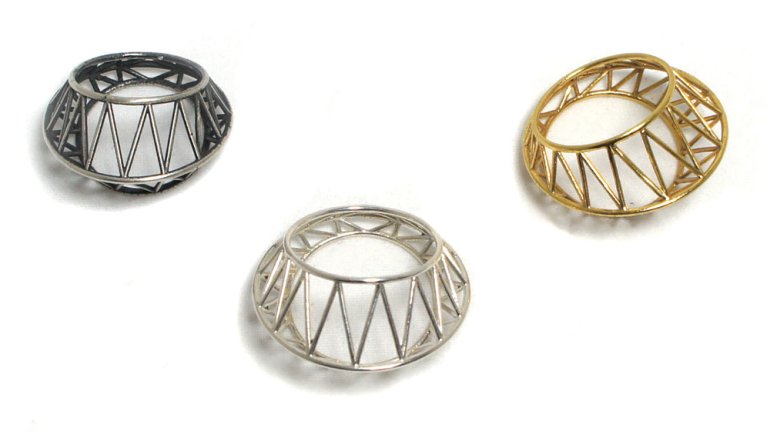Shape Shifter
Shape Shifter
At her studio in south philadelphia, surrounded by pizza parlors, cafés, and grandmothers who still sweep the front stoop, Maria Eife is busy sketching ideas for a new jewelry collection. Inspired by ornate styles from a gamut of eras – ancient times, the Victorian era, the swinging ’60s – Eife’s bold, geometric designs stand out not only for their shapes and materials, but also as another instance of designers using 3D-printing technology.
For the past few years, the South Jersey-born designer has been using the power of 3D printing to create some of her most striking work, including new Pleated earrings and Cage rings. “When I first started participating in the high-end fine craft shows in 2011, I was not sure how people would receive it,” admits the 37-year-old, an invited artist at past American Craft Council and Martha Stewart Holiday Craft shows. “But my experience was nothing but positive. Most people were very excited, intrigued, and sometimes confused. I would hear over and over again that this was the first 3D-printed object they had ever seen in person.”
Ever since the technology went mainstream, it began offering Eife a variety of new materials, such as bronze-infused steel, to play with at 3D printers throughout the city. “Right now the most common materials are plastics,” she says, which have lent themselves to a few of her recent designs, including the Cage and Linked Loops bangles. “The most exciting material I recently heard about is direct gold printing,” she says, which harks back to her early days at the Tyler School of Art, where both traditional jewelry making and digital techniques are taught.
“I was drawn to study jewelry, specifically contemporary art jewelry, because of the combination of skill and art and concept that can be present,” Eife says. “I liked the challenge of learning the skills alongside the cultivation of ideas.”
Since then, Eife has taken a few unexpected creative turns that led her into the 3D world. She adopted laser-cutting early on. Her Binary necklaces, the first collection she presented, are cut in industrial wool felt and remain among the most popular in her increasingly sophisticated collection.
Almost all of Eife’s jewelry, which honors the geometric legacies of greats such as Alexander Calder, Issey Miyake, and industrial designer Gijs Bakker, is created using some sort of digital design or fabrication. “The design and production process work together to create the final piece,” she says. “As with most mediums, it’s a conversation between technique and concept.”
Her new Cage bangle is made using a selective laser sintering printer that solidifies nylon powder in whatever form she designs. The process, she says, is ideal for jewelry with fine details or moving parts, and the material is porous, which allows Eife to dye the pieces any color, including the bright hues of her recent work.
“Most of my pieces are made with this printer,” she explains, “though I am working on a few new ideas. Sometimes I have a concept, like in the Binary jewelry, and other times it is just an exploration of form and geometry.” And the best part about it? “When it is all done, you can wear it. It’s very rewarding.”
Natalie Hope McDonald is a writer and editor in Philadelphia.

